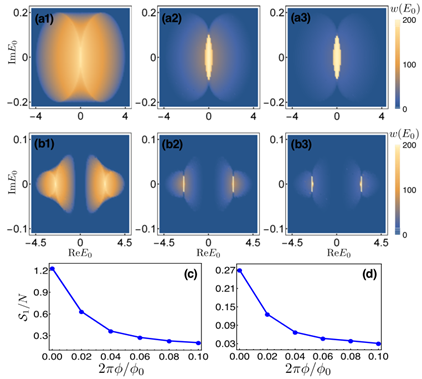Ming Lu and Colleagues Made Important Progress in the Study of Non-Hermitian Skin Effect
2021/12/21
Recently, assistant research scientist Ming Lu from the group Ultrafast Optical Manipulation and Imaging in BAQIS, together with Dr. Xiao-Xiao Zhang and Prof. Marcel Franz from the University of British Columbia, have made important contribution to the field of non-Hermitian physics. Their work entitled magnetic suppression of non-Hermitian skin effect has been published in Physical Review Letters.
Non-Hermitian physics has drawn intensive research interests in recently years. As an effective description, non-Hermitian Hamiltonians have a wide range of applications, including optical systems, modeling subsystems with an environment and the descriptions of quasiparticles in solids with disorder or interaction. Unique features have been found with no Hermitian counterpart, such as exceptional degeneracy and non-Hermitian skin effect, which have already been confirmed in experiments. Non-Hermitian skin effect, where macroscopically many states are localized near the boundaries, plays a pivotal role in explaining the breakdown of conventional bulk-boundary correspondence and the huge discrepancy between the open and periodic boundary spectra in many non-Hermitian systems. Meanwhile, as an effective probing and manipulating method, magnetic field has proven to be fundamentally important in Hermitian systems. Yet, its effects in non-Hermitian systems have only been addressed in some specific scenarios. In this work, Ming Lu and the colleagues studied a more generic problem, namely, the interplay of non-Hermitian skin effect and the magnetic field. They found that although the non-Hermitian skin effect has a topological origin, applying magnetic field can effectively suppress it. Skin states originally localized at the boundary are pushed back into the bulk by the magnetic field. To demonstrate this effect, they solved different types of the low energy effective Hamiltonians. The analytical results agree well with the numerical results of the lattice models (Fig. 1). For higher energy wave functions, by numerically solving the lattice models, the averaged center of the wave functions also moves toward the bulk.

Fig. 1 Wave function amplitudes for the lowest three energy levels. (a). Skin states without magnetic field for lattice model; (b). lattice model with magnetic field; (c). low energy effective model with magnetic field.
The presence of skin modes corresponds to the existence of some energies in the complex-energy plane such that the following winding number is nontrivial:

From the topological aspect, Ming Lu and the colleagues defined a winding number averaged topological non-trivial area as a quantitative indicator of the suppression phenomenon (Fig. 2). For the rational flux, the determinant in the above formula has a simple form, thereby the winding number can be calculated rather efficiently. By numerical calculation, they found that the shrinking of skin topological area also holds at higher magnetic fields in general. Besides, the generalized Brillouin zone (GBZ) with rational flux has a simple analytical form. Specifically, the GBZ for the one band model is independent of the magnetic flux, pointing out the unique irrelevance of GBZ in describing the magnetic suppression of non-Hermitian skin effect. As the techniques to generate (synthetic) magnetic fields have been well established in several candidate non-Hermitian systems, this work may motivate further investigations of the magnetic effects in the non-Hermitian systems.

Fig. 2 Topological winding numbers in the complex-energy plane. One-band (a1-a3) and two-band (b1-b3) model with magnetic flux 0, 0.04, and 0.08 respectively; winding number weighted skin topological area for one-band (c) and two-band (d) models.
This work is supported by the National Basic Research Program of China, the Strategic Priority Research Program of Chinese Academy of Sciences, the Max Planck-UBC-UTokyo Center for Quantum Materials, NSERC, CFREF and Riken SPDR program.
Article link: https://journals.aps.org/prl/abstract/10.1103/PhysRevLett.127.256402
 中文
中文 Email
Email QCloud
QCloud Log in
Log in
